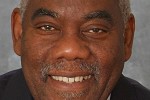By Dr Selwyn R. Cudjoe
June 23, 2020
“White men, I curse you to your face,/ Curse you and all your hated race!/ Great war has placed me in your power;/ I am your captive; this is your hour/ To wreck your bitterest thought of ill;/ To bind or slay me as you will.”
—Horatio Nelson Huggins, Hiroona
 I do not have strong feelings as to whether we should move Columbus’s monument from its present location or whether it should be placed in a special museum. However, I am encouraged by the discussion the issue has engendered and the eloquent articles it has generated.
I do not have strong feelings as to whether we should move Columbus’s monument from its present location or whether it should be placed in a special museum. However, I am encouraged by the discussion the issue has engendered and the eloquent articles it has generated.
I am more concerned with the havoc the Europeans have wreaked on our civilization after Columbus’s arrival, the genocide that was perpetrated against our indigenous populations, and the subsequent barbarity to which brown and black people have been subjected.
Forty years after Columbus arrived in the New World Bartoleme de Las Casas, in his Tears of the Indians (1543) acknowledged that over 40 million native peoples were massacred by the Europeans during that short period.
In the 19th century, under the leadership of President Andrew Jackson, Euro-Americans removed approximately 100,000 native people (including the Cherokee, Creek, Chickasaw, Choctaw and the Seminole) from their land. President Donald Trump, an admirer of Jackson, excavated Jackson’s portrait and displays it in the White House.
Both Gloria Jahoda and John Ehle documented the genocide of these native peoples in The Trail of Tears (1975) and Trail of Tears (1988) respectively. The Indian land was paved with gold. The white man wanted it. Therefore, he removed the Indians from their land.
In the 1830s the white man rounded up the Creeks and other Indian groups and placed them in reservations. The Montgomery Advertiser reported: “The Red Man must soon leave. They have nothing left on which to subsist. Their property has been taken from them-their stock killed up, their farms pillaged-and by whom? By white men.”
Ehle described the Creeks’ tragic situation: “In early June [1835] Chief Eneah Emathla was captured, and a thousand of his people, including women and children, surrendered. Mounted on ponies-most of them-they rode into captivity and were duly imprisoned. Two other chiefs, Jim Henry and Eneah Micco, were conquered soon after.
“On July 2 hundreds of revolutionaries were dispatched to the West. Moving slowly, the men were manacled and chained, even Chief Eneah Emathla, who was about eighty-four years of age. His head was high, his eyes blazing; he was uttering not a word of complaint as he faced the western, setting sun.”
Pride and defiance were etched on every inch of Chief Emathla’s face. The Cherokees and other groups were also rounded up and placed in reservations. In an ironic twist of fate, we T&T, during the 1950s and 1960s applauded loudly in cinemas as the Indians were killed by the white men.
When Columbus arrived in Trinidad in 1498, he met several ethnic Amerindian groups living in the island. They included the Arawak, the Parico, Jaio, Salivas, Nepuyo, Chimas, Calipuna, and Tamanaco. The Amerindians called their island “Kairi.” The Arawaks were the principal group. Another group of Amerindians, called variously Carina, Callinago, and Carinepogotoes, were renamed Caribales or “consumers of human flesh,” because the Spanish believed they ate human flesh.
Elma Reyes noted that the Spaniards resented them because they were most successful at resisting the “toys and other trinkets displayed by Columbus and in defending themselves against attacks by the newcomers.” Claudius Fergus, in an illuminating article, outlined the fierce resistance of Caciques Anacaona, Baucunar, and Goanagoanare against the Spaniards (Express, June 17).
In my edited work Narratives of Amerindians in Trinidad and Tobago, which I did with the encouragement of Chief Ricardo Bharath Hernandez, chief of the Santa Rosa First People’s Community, I outlined the Amerindian presence in the island. I tried to recover some of the poems (e.g., Frank Kums, “Those who Lept in Grenada,”), Lionel Bernard Tronchin’s tale, Inez, or the Last of the Aroucas, and Jean-Charles De St. Avit’s drama, “The First Two Martyrs of Trinidad: A Tragedy in Four Acts.”
I also reproduced Eusebio Atanasio Valerio’s Sieges and Fortunes of a Trinidadian in Search of a Doctor’s Diploma, perhaps the only autobiographical work that we have of a native Trinidadian. Valerio says: “I was born in a miserable little thatched hut, on the outskirts of the small village of Tortuga.
“My father and mother were known respectively as Jose Tiburico Valerio and Eleonore Valerio; both being natives of the island. From them I have inherited a natural legacy, which it is perhaps the privilege of comparatively few people to fall heir to….This legacy consists of a mixture of three strains in my blood: the Caucasian, the Indian and the Negro.”
In Manhattan he was called “a nigger” and physically removed from a restaurant that refused to serve him. “I could not stop to tell him [the person who threw him out] that in my country I was not considered a ‘nigger.'”
I also included “Carib Etymology of Certain Words” (1888) that examined the Carib language “for the etymology of the names of places, mountains, etc., lands the Carib occupied at the time of the discovery of the American continent.” The author was drawn to the Carib language. He felt it was more interesting for an amateur of ethnology than the languages of the Hurons, the lroquois, and the Sioux.
Removing Columbus’s statue and renaming our streets and parks after local heroes will be a progressive move. However, it will do us little good if we do not dedicate ourselves to learning about our past and how it contributes to what Professor Gurminder Bhambra calls “a more expansive self-understanding.”
